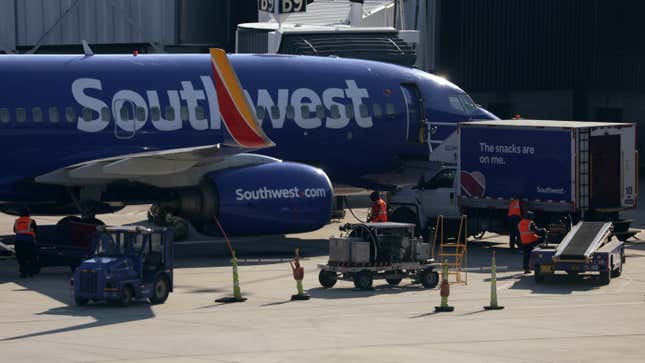
As angry as passengers have been during this past week of delayed and canceled flights, lost luggage, and being stranded far away from friends and family during Christmas, that was apparently nothing compared to what Southwest Airline ground crew workers experienced, according to a union letter claiming some workers developed frostbite during 16-hour shifts where they were exposed to sub-zero temperatures for extended periods.
The Transport Workers Union of America Local 555 claims to represent 17,000 Southwest Airlines ground crew workers. On Wednesday, TWU Local 555 President Randy Barnes said in a release that a good chunk of their members were working 16- to 18-hour shifts this holiday season. Some were getting sick, and he said some experienced frostbite during the incredibly cold temperatures seen this past week.
“People need to be able to cycle in and out of the cold,” Barnes wrote. “The airline needs to do more to protect its ground crews.”
A leaked email Southwest sent to workers in Denver, Colorado shows the company declared an internal “State of Operational Emergency” starting Dec. 21. The memo shows that ramp workers were required to work overtime, and if they were sick, they were also required to provide a doctor’s note—and not from any doctor seen via telemedicine. The memo was first reported by Business Insider Wednesday, which claimed the document was confirmed by the company.
Colorado then suffered -15 F average temperatures on Dec. 22, some of the lowest recorded temperatures the state has ever experienced. That is all before wind chill, which can be the deciding factor in whether a person suffers frostbite.
In the release, Barnes further criticized the Dallas, Texas-based airline for scheduling so many flights even though its owners understood the weather conditions. He said Southwest needs to space flights out more during extreme weather, not just extreme cold but extreme heat.
Gizmodo reached out to the union to better understand what the severity of sickness and frostbite was for Southwest ground crews, but we did not immediately hear back. We also reached out to Southwest for comment on its policies for ground crew during inclement weather, but the company declined to comment. Southwest told Insider that the company can contractually implement these emergency procedures for ramp workers.
Depending on exposure, temperature, and wind chill, it can take a very short time to develop frostbite. The National Weather Service includes a chart on its page showing the temperature and wind speed required to result in frostbite in 30 minutes, 10 minutes, or just five minutes. The agency noted an individual in a wind chill of -20 F would take 30 minutes to develop frostbite. Of course, milder forms of frostbite, sometimes called “frostnip,” can be treated with home care, though of course it’s important to see a doctor to gauge the severity and receive accurate treatment.
Southwest has canceled thousands of flights since the winter storm started mucking up people’s holiday travel plans. The airline nixed 2,400 flights for Tuesday and another 4,800 for Wednesday and going into Thursday. Southwest has done away with close to 16,000 flights since Dec. 22. An executive of Southwest Airlines’ pilot association blamed Southwest’s decaying scheduling software for much of the travel chaos. The airline was also dealing with a lack of staff.
Instead of answering our questions, the company pointed to a video with Southwest CEO Bob Jordan released Tuesday. Jordan said:
“The operation of the airline counts on all the pieces, especially aircraft and crews remaining in motion to where they’re planned to go. With our large fleet of airplanes and flight crews out of position in dozens of locations. And after days of trying to operate as much of our full schedule across the busy holiday weekend, we reached a decision point to significantly reduce our flying to catch up.”
As Barnes mentioned in his release, Southwest was originally envisioned by co-founder Herb Kelleher as a point-to-point airline that avoided the excesses of other major plane-based businesses across the country. Since Kelleher left his position as CEO and passed in 2019, Southwest has started to more resemble its pricier competitors. Still, the company lags behind in many ways, as evidenced by how it’s dealt with crisis after crisis, like back in 2014 when the company canceled thousands of flights and lost hundreds of pieces of luggage due to harsh winter weather. Last year, the company canceled more than 2,000 flights during another rash of bad weather, and similarly blamed staffing shortages.
This failure to operate during the ongoing crisis now has the federal government breathing down Southwest’s neck. On Tuesday, Transportation Secretary Pete Buttigieg made special mention of Southwest Airlines to NBC Nightly News, saying that while other airlines’ services have improved, “they have moved in the other direction.” He said that Southwest has “crossed the line from what is an uncontrollable weather situation to something that is the airline’s direct responsibility.”
Buttigieg added “they need to take care of their passengers and they need to take care of their employees.” The New York Times also reported that Indiana Sen. Maria Cantwell said in a statement that the Senate Commerce Committee would investigate Southwest.
This recent winter storm swept east across North America and hit the east coast on Friday, where it has buried areas like Buffalo, New York under several feet of snow, delaying rescue workers and otherwise halting traffic under whiteout conditions. As of Tuesday, federal officials said the storm has claimed at least 63 lives, though of course that number will likely rise in the coming days.

